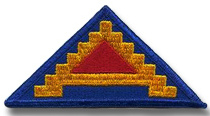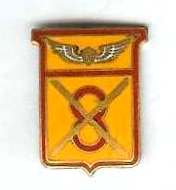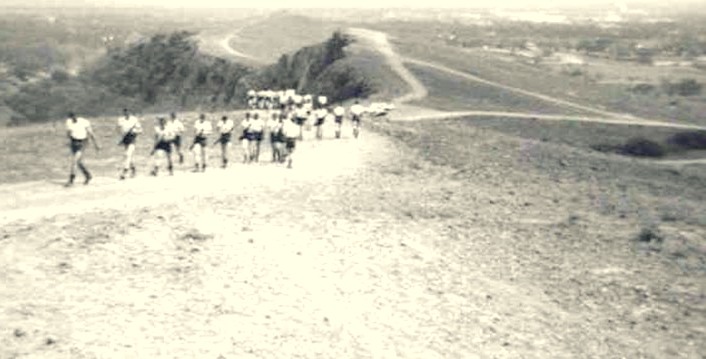
HISTORY:
"A Stitch In Time" – Both America's... and Mine!
February 20, 1962 to February 19, 1965

7th Army Patch - "The Seven Steps To Hell"
A timeline of some primary events during the "Cold War":
April 17–19, 1961 - The Bay of Pigs invasion
http://en.wikipedia.org/wiki/Bay_of_Pigs_Invasion
http://wiki.answers.com/Q/What_was_the_date_the_Berlin_Wall_officially_put_up
http://www.history.com/this-day-in-history/an-american-orbits-earth
http://en.wikipedia.org/wiki/Cuban_Missile_Crisis
June 26, 1963 - President John Kennedy gave his famous speech at the Berlin Wall
http://www.pbs.org/newshour/rundown/2013/06/famous-berlin-speeches.html
http://www.army.mil/-news/2009/10/18/28749-operation-big-lift/
http://en.wikipedia.org/wiki/John_F._Kennedy_assassination
*"It was a dark and stormy time"... those years dating from the late 1940's to the early 1990's -- better known as the "Cold War" years. But, history has shown the year, 1962, and the years just before and just after, were an especially important time in American history (and, by the way -- it was especially important in my history, too!)
As you may know (if you don't, you certainly should), beginning in the spring of
1961, the Bay of Pigs Invasion, an invasion of Cuba had been attempted.
It failed -- terribly! Diplomacy between the US and Russia, which had
been ‘chilly’ to begin with, now deteriorated even further. Over the
intervening months, diplomacy between the two countries now
unraveled into a ‘reality game’ of Russian Roulette.
Basic Training:
Normally, I would have been sent to Fort Dix, NJ. As It was February, and very cold, I requested a warmer location. The Army flew me from Albany to Fort Jackson, SC. for my Basic Training.
Advanced Basic Training:
Since I had requested an
assignment related to Fixed or Rotary Wing aviation, after Basic, I was sent to
Fort Rucker, AL (another warm location). There I received training
as a Flight Operations
Specialist, (MOS 907.10).

Duty Assignments:
As mentioned, I had requested being assigned to a
European Base. Germany was selected. So,

This is just one of the 90th Transportation
Company's Sikorsky CH-37-B "Mojaves" (Note the unit's markings)
( http://www.aviastar.org/helicopters_eng/sik_s-56.php)
I worked in the Base’s "Flight
Operations" office. The function of a Flight Operations
Specialist was to:
1.
Communicate with other Amy
units on a daily basis, with regard to all flight activities and
military missions that affected the unit,
2.
Receive, open or close,
record and communicate all activity on flight plans filed for
flights leaving or arriving at our facility,
3.
Receive the initial
notification of military
missions assigned, aid in allocating, tracking and recording
resources (aircraft, pilots and anything else required to complete
the currently assigned missions,
4.
Maintain a “library” of
aviation charts and maps of the operational area which are
constantly filed, re-filed and updated,
5.
Aid and assist the
individual unit pilots to ensure their personal charts and maps are
current and correct, as well.
At one point, I was sent on
temporary assignment, to assist in “Operation Big Lift”.
This was during the period
when the “Cold War” with Russia was really heating up! It was after
the “Bay of Pigs” fiasco and then the erection of the “Berlin Wall”
by the Russians.
This operation ran from October to December of 1963. It required the movement of an entire Army division from Texas to Germany – in 24 hours! The purpose of this, was to show the Russians that we intended to retain a presence in Berlin – by going through their occupied sector. (I worked as an “Air Traffic Controller”) at a field being used by all the high-ranking officers (and their personal helicopters) to gather and critique “Operation Big Lift”. http://www.army.mil/article/28749/

The Air Traffic Control Tower at Storck Barracks, Illesheim, Germany
I spent two and half years at Illeshiem Army Airfield, Germany
in the 90th Transportation Company, H-37 Mojave. June of 1962
thru December 1964 as the company clerk. We had 16 H-37 and 1
small bell. Major Fredrick Dawson was in command.”
"francis j oconnor,
oconnor237@live.com, 20.03.2011
I served with the 90th transportation co. from 1961 to 1964 in Illeshiem germany willy permansu was the company cleark Billy
mynahan was in the motor pool sargant bantugun was the 1st
sargent they called me shorty if anyone remembers contact me at
oconnor237@live.com “
Note: Walter is the "Willy" referred to by "Shorty" O'conner in his piece above.
OCS Field Artillery-- Robinson Barracks at Fort Sill, OK.

I took the normal training
provided to Officer Candidates, both class and field work. We took
turns holding the various positions that a Line Officer would fill
in real life. There were days firing the guns (105s and 155s) and
other days when we were the Forward Observer, calling in adjustments
to the fire impact coordinates. We all went up through the ranks.
First, Lower Classmen then, Middle Classmen and finally, Upper
Classmen.
Of course, we all discovered the “Jark”!

The last week of OCS is called
“Zero-Week”. This is the week following all training. It is at this
time that the Army issues the future Second Lieutenants their
officer’s serial number, officer’s uniform and new assignment
orders.
It was at this time that I was
first informed that the air field, and the flight training school located
on it, would not be funded by Congress. Therefore, the base and the
flight training school I had been expecting to attend, was not going
to be available! The Army then offered me the choice of several
temporary assignments until a seat opened up – if, one did.
Supposedly, this would just be until they could find an open seat
and re-assign me to that flight school.
I had four choices; but none
of them were very inviting!
Now I had a dilemma! if I
graduated with my OCS class, I would become a Second Lieutenant, but
-- I would have to re enlist for three more years! However,
if I chose not to graduate, my enlistment would run out in three
days!
That seat at a different
flight school was just too much of a gamble for me! So, a day or so
before the class graduated, I wrote a letter resigning my
commission. Since I chose not to graduate with my OCS class, my Army
enlistment would now expire in only three days!
I used those three days to
“Clear Post” (i.e., turn in uniforms/gear, collect my laundry, pay
any outstanding bills etc.) On February 19, 1965, I became a
civilian again (even though, technically, I was still in the
Inactive Reserve for 6 more years).
Interestingly, as it turned
out much later, 1965 was the year the US greatly increased the
deployment of troops to Vietnam. The troop count reached
200,000.
One of those “temporary”
assignments mentioned earlier was: “Artillery Forward Observer”
in Vietnam! (I was told
that a FO’s life expectance was estimated, at that time, to be
approximately 30 to 45 minutes.)
If you should care to, you can read
about the experiences of other former OCS candidates, as told in
their own words, here: http://www.faocsalumni.org/documents/ocsmemories.pdf

"When I die I'll go to Heaven because I've served my time in Hell"